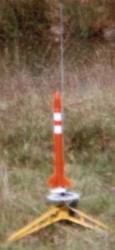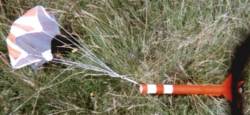Scratch Mark II Original Design / Scratch Built
Scratch - Mark II {Scratch}
Contributed by Darren Longhorn
| Manufacturer: | Scratch |
(Contributed - by Darren Longhorn)
 The body was
made from an aluminium foil core, a tube approximately 25mm in diameter and
300mm long. It had balsa fins, right angled triangles about 50mm long on the
opposite and adjacent sides. The fins passed through the body tube and formed
spacers onto which the engine mount would fit. The engine mount was made from
floppy disk labels again, with 1mm solid copper wire as the engine restraint
& retainer.
The body was
made from an aluminium foil core, a tube approximately 25mm in diameter and
300mm long. It had balsa fins, right angled triangles about 50mm long on the
opposite and adjacent sides. The fins passed through the body tube and formed
spacers onto which the engine mount would fit. The engine mount was made from
floppy disk labels again, with 1mm solid copper wire as the engine restraint
& retainer.
The best thing about this rocket was the nose cone, which was turned from balsa on a lathe, by local school teacher Brian Thompson, thanks again Brian. Attached to the nose cone was a peizo -electric buzzer, to help locate the rocket after recovery. To ensure safe recovery I bought an Estes parachute, I've never had much luck with streamers.
I flew the MkII about a dozen times on various B & C size Estes engines, and had some success. I did have one recurring problem though which was that the shock cord would break after 2 or 3 flights. What normally happened was that the nose cone would become detached, and the main body would recover normally, although it would travel a long way if there was ANY cross wind. Fortunately I could always find the nose cone, because of the buzzer. However on the last flight not only did the nose cone detach, I think the parachute and body separated too. It was hard to tell, but the parachute blew away really quickly and didn't show any signs of coming down. What happened to the body remains a mystery, we never did find it.
 Well it was nearing the end
of its life anyway as the engine mount was becoming very ragged, and there was
a real knack to getting a new engine in. The engine mount was always a bit
askew ( which meant it always went up at about 5° from the vertical) and
the trailing edges of the fins were being burnt away.
Well it was nearing the end
of its life anyway as the engine mount was becoming very ragged, and there was
a real knack to getting a new engine in. The engine mount was always a bit
askew ( which meant it always went up at about 5° from the vertical) and
the trailing edges of the fins were being burnt away.
Sponsored Ads
 |
 |











